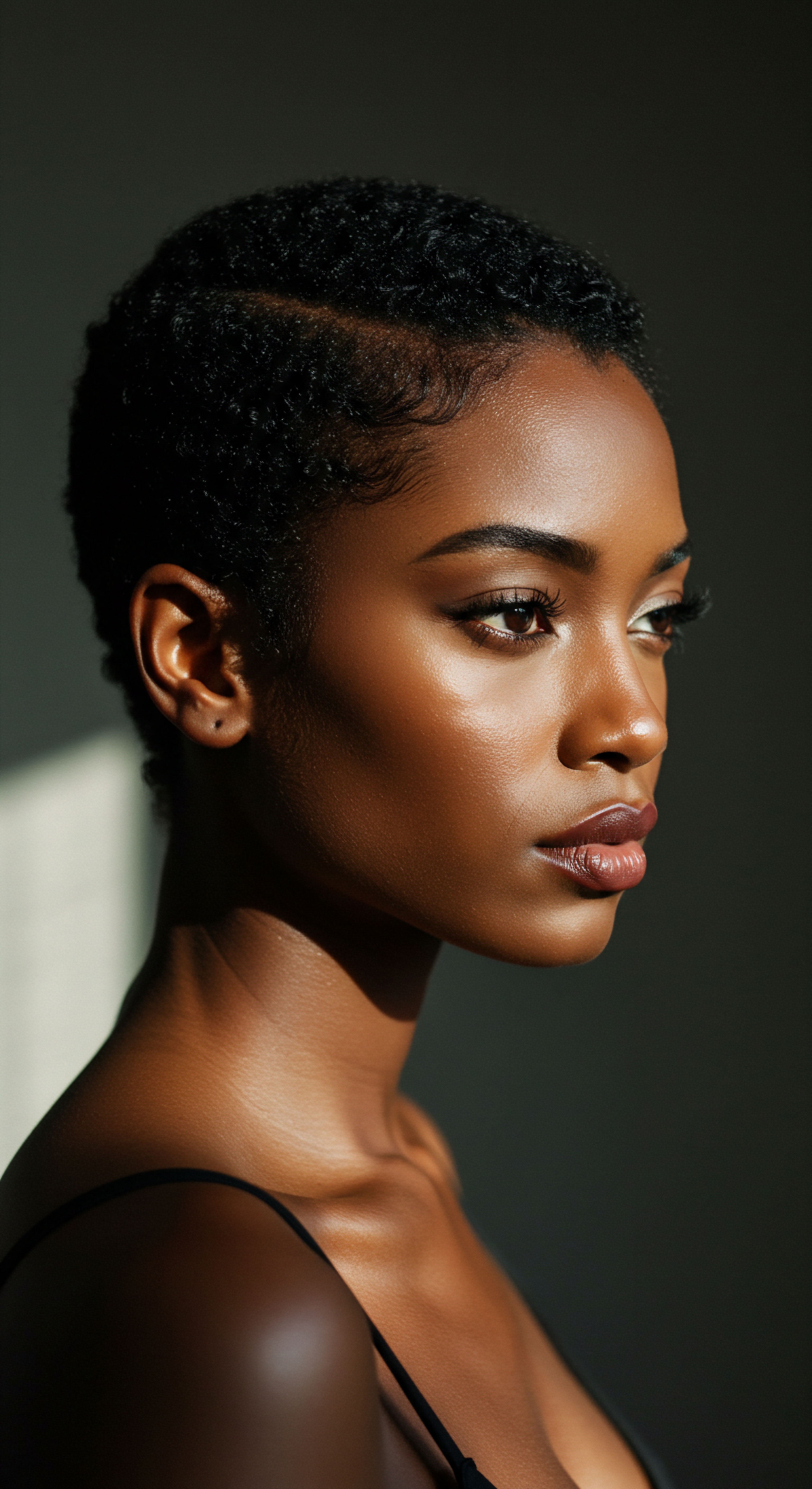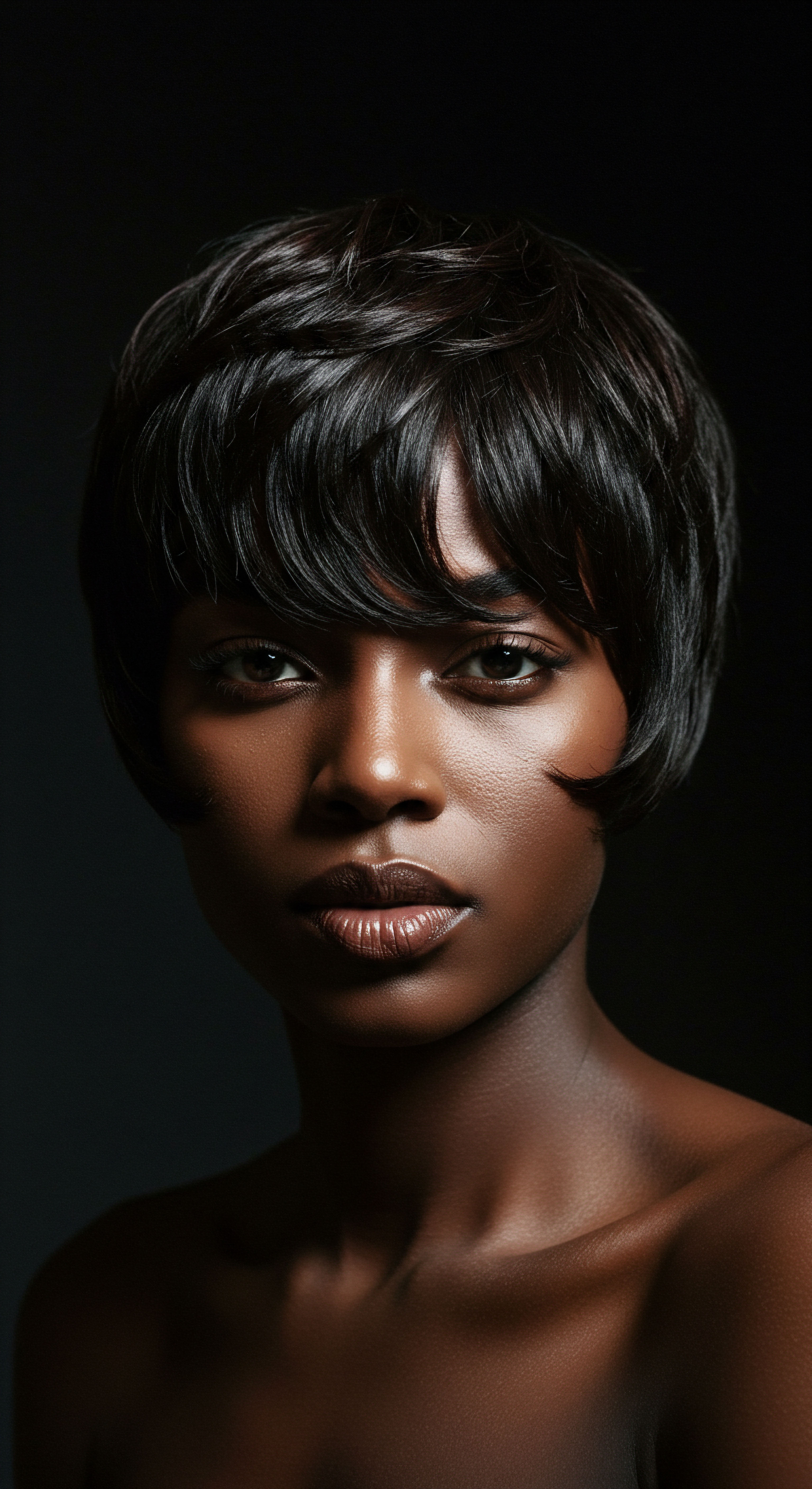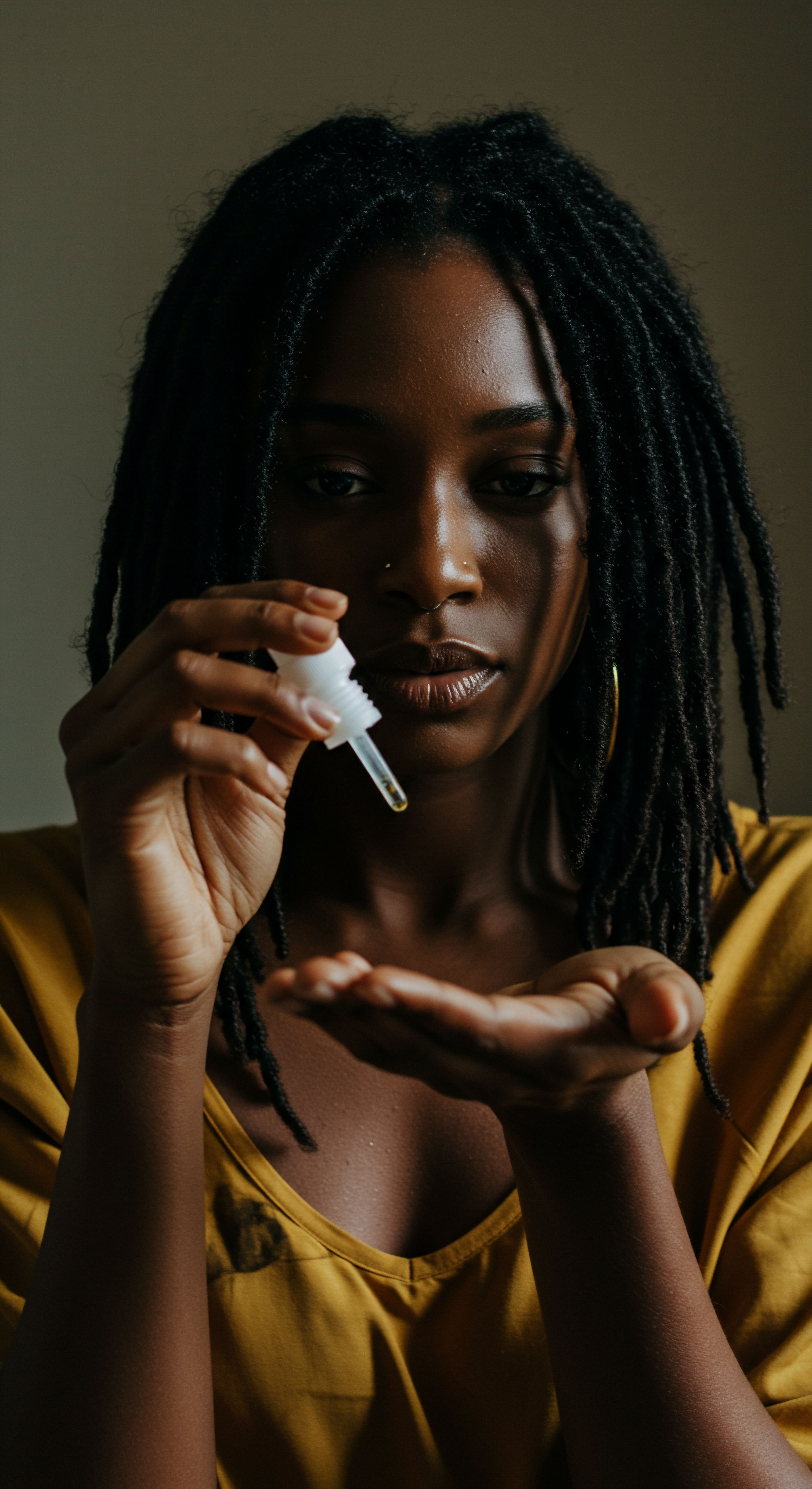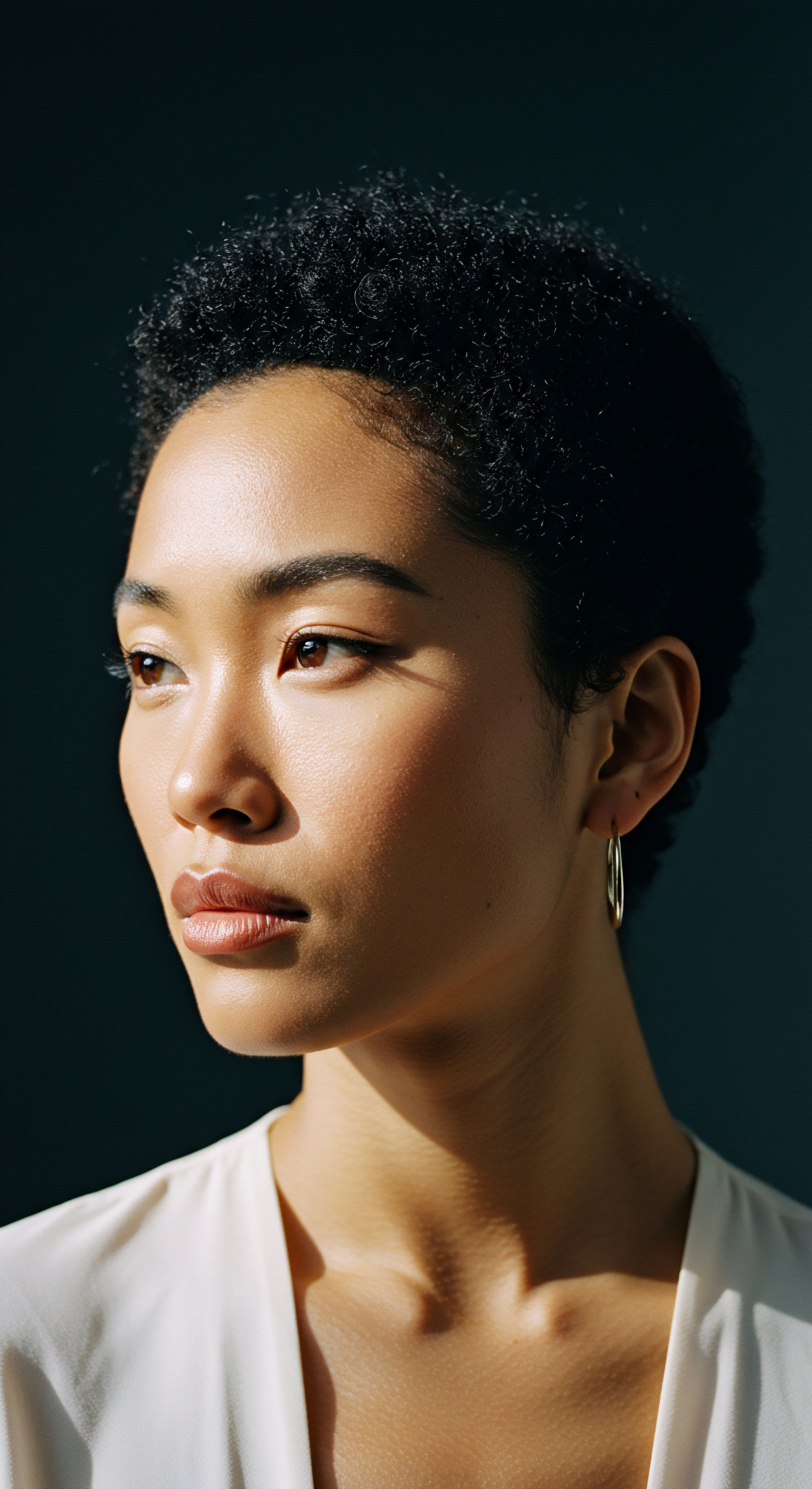
Roots
The journey of textured hair care practices begins not with a product, but with a whisper from antiquity, a gentle echo from lands where the sun kisses the skin and hair grows in magnificent, resilient spirals. To truly appreciate the story of coils, curls, and waves, we must first turn our gaze to pre-colonial Africa, a continent rich with diverse cultures and profound connections to personal adornment. Here, hair was far more than mere strands; it served as a living canvas, a communicative tool, and a spiritual conduit.
Across various African societies, hairstyles spoke volumes. A glance could convey a person’s age, marital status, social standing, religious affiliation, wealth, or even their tribal identity. The meticulous attention given to hair was not vanity, but a deep cultural expression.
Women, in particular, spent hours, sometimes days, styling hair, a communal practice that strengthened social bonds and passed down ancestral wisdom. This was a time when hair was intrinsically tied to identity and community, a direct reflection of one’s place in the world.
In ancient African societies, hairstyles served as a profound visual language, communicating identity, status, and community ties.

Hair as a Symbol in Ancient Africa
In many ancient African civilizations, hair was regarded as the most elevated part of the body, a direct link to the divine. This spiritual reverence meant hair care was often a ritualistic affair, involving natural butters, botanical concoctions, and indigenous oils. These practices were not solely for aesthetic appeal; they also served to protect the hair from environmental elements like harsh sun and drying winds, preserving its health and integrity.
For example, the Yoruba people of Nigeria crafted elaborate hairstyles that symbolized community roles and spiritual beliefs. A woman’s thick, clean, and neat braided hair often signified her ability to produce bountiful farms and bear healthy children. Conversely, undone hair could indicate depression, neglect, or even mental distress in some Nigerian cultures. This connection between hair and societal well-being highlights a perspective where hair care was inseparable from overall community health and spiritual alignment.
- Hairstyle ❉ A visual lexicon, communicating social standing, age, marital status, and spiritual beliefs.
- Natural Ingredients ❉ The reliance on butters, oils, and botanicals, reflecting a deep connection to the earth’s bounty for hair health.
- Communal Care ❉ Hair styling as a shared activity, reinforcing social structures and intergenerational learning.

The Science of Early Care
The practical knowledge of textured hair in ancient Africa was, in its own way, scientific. Communities understood the unique properties of coily and curly strands, recognizing their need for moisture and gentle handling. The use of oils and butters provided conditioning, while intricate braiding and twisting patterns served as protective styles, minimizing manipulation and breakage. These methods safeguarded the hair, allowing it to flourish in its natural state.
The coiled structure of textured hair, a natural adaptation to hot, sunny climates, provides insulation to the scalp and helps retain moisture in dry environments. Early practices intuitively supported these biological characteristics. The very act of cleansing involved methods that respected the hair’s structure, preventing excessive stripping of natural oils. This foundational understanding, passed down through generations, laid the groundwork for sophisticated hair care practices long before modern chemistry entered the scene.

Ritual
Stepping from the ancient echoes of hair’s foundational significance, we move into the realm of daily practice, where ancestral wisdom meets the practicalities of maintaining textured hair through changing times. Our shared desire for healthy, well-tended hair finds its expression in the rituals we adopt, the tools we choose, and the moments of quiet care we dedicate to our strands. This section invites us to consider how these routines, whether ancient or contemporary, shape our experience and connection to our hair.
The transatlantic slave trade drastically altered the landscape of textured hair care. Forced displacement from ancestral lands severed access to traditional tools, indigenous ingredients, and the communal settings where hair care rituals once thrived. Enslaved Africans often had their heads shaved upon arrival, a dehumanizing act intended to strip them of their identity and cultural ties. This brutal imposition marked a profound shift, compelling individuals to adapt and innovate with severely limited resources.
The forced disruption of traditional African hair practices during slavery spurred innovative, often difficult, adaptations in hair care.

Adapting to New Realities
Despite the oppressive conditions, resilience shone through. Enslaved individuals found ways to preserve elements of their hair traditions, often using what was available ❉ cooking oils, animal fats, and even butter for conditioning. Scarves and head wraps, initially used for protection and to conceal matted hair, transformed into powerful symbols of resistance and self-expression. Braiding, too, persisted, sometimes serving as a coded language for escape routes or a quiet act of cultural defiance.
The period post-emancipation presented new challenges. While physical freedom was gained, the psychological weight of Eurocentric beauty standards loomed large. Straight hair became a prerequisite for social acceptance and economic opportunity, leading to widespread adoption of methods like hot combs and chemical relaxers. These tools and chemical concoctions, often harsh and damaging, represented a difficult compromise between cultural identity and societal pressure.

The Rise of the Hair Care Industry
The early 20th century witnessed the emergence of Black women entrepreneurs who recognized the unmet needs of their community. Pioneers like Madam C.J. Walker and Annie Turnbo Malone built empires by developing specialized hair care products for textured hair. Their products, though often promoting straightening, also offered solutions for hair health and growth, creating economic opportunities for countless Black women who became agents and stylists.
For instance, Madam C.J. Walker’s “Wonderful Hair Grower” became a household name, providing jobs and economic independence to thousands of Black women across the United States. Her business model, involving door-to-door sales and training programs, empowered women not only with hair care solutions but also with business skills, a remarkable achievement in an era of severe racial and gender discrimination. This era, while promoting straightening, also laid the foundation for a Black-owned beauty industry that served its community.
- Hot Combs ❉ Invented in the late 1800s, these metal tools became popular for temporarily straightening hair, offering a non-chemical option.
- Chemical Relaxers ❉ Introduced in the early 20th century, these formulations, initially containing lye, offered longer-lasting straightening but often came with risks of scalp damage and hair breakage.
- Head Wraps ❉ A practical and symbolic accessory, used for protection, concealment, and later, as a statement of style and identity.

Relay
Our journey through the history of textured hair care now arrives at a deeper stratum, where the scientific understanding of strands converges with profound cultural meaning. We consider how societal shifts, scientific revelations, and the enduring human spirit have collectively shaped the practices and perceptions surrounding coils, curls, and waves. This section delves into the intricate connections that elevate hair care beyond mere grooming to a testament of identity, resilience, and evolving knowledge.
The mid-20th century marked a significant turning point with the Civil Rights and Black Power movements. The “Black is Beautiful” sentiment challenged Eurocentric beauty norms and championed the natural aesthetics of Black people, including their hair. The Afro became a powerful symbol of pride, resistance, and self-acceptance, a visible declaration against assimilation. This cultural shift brought a renewed interest in natural hair care, sparking a movement that continues to resonate today.

How Did Scientific Understanding of Hair Texture Influence Care Practices?
Scientific understanding of textured hair has steadily advanced, moving beyond surface-level observations to a deeper comprehension of its unique structure. Textured hair, characterized by its tightly coiled strands and curved follicles, possesses distinct properties compared to straight hair. It is more prone to mechanical extension failure and breakage, and its structure often results in higher porosity. This inherent structure affects how hair absorbs and retains moisture, making moisture retention a central concern for many with textured hair.
Early scientific inquiries, though sometimes framed within a Eurocentric lens, gradually contributed to a better understanding of these properties. For example, research has demonstrated that curly hair results from a curly follicle and asymmetry in the mitotic zone. This understanding underpins the need for specialized products and techniques that address the specific needs of textured hair, such as moisture-sealing methods and gentle handling to prevent breakage.

The Porosity Paradox and Product Development
The concept of hair porosity, referring to the hair’s ability to absorb and retain moisture, has gained significant attention within the textured hair community. High porosity hair, with its more open cuticles, absorbs moisture quickly but loses it just as fast, while low porosity hair resists moisture absorption but retains it well once absorbed. This understanding has directly influenced the development of product layering techniques, such as the LOC (Liquid, Oil, Cream) or LCO methods, designed to seal moisture into the hair.
This scientific insight into porosity highlights a fascinating intersection of biology and consumer behavior. While porosity can be influenced by genetics, it is also significantly impacted by hair grooming practices, including chemical and physical damage. Repeated chemical treatments and heat styling can increase hair porosity, leading to greater damage and moisture loss. This underscores the importance of informed product choices and gentle routines.
| Porosity Type Low Porosity |
| Characteristics Cuticles lie flat, resists water absorption, prone to product buildup, retains moisture well once absorbed. |
| Care Approach Lightweight products, gentle heat for absorption, clarify regularly. |
| Porosity Type High Porosity |
| Characteristics Cuticles are open or raised, absorbs moisture quickly, loses moisture fast, prone to frizz and dryness. |
| Care Approach Heavy butters and oils, layering methods (LOC/LCO), protein treatments. |
| Porosity Type Understanding porosity helps tailor hair care routines for optimal health and hydration. |

What Economic and Social Forces Shaped Textured Hair Practices over Time?
Beyond the scientific, powerful economic and social forces have continually shaped textured hair care practices. The beauty industry, for centuries, largely catered to Eurocentric standards, leaving the textured hair market underserved. This disparity created a vacuum that Black entrepreneurs bravely filled, establishing a parallel economy.
Consider the striking economic reality ❉ Black consumers spend a disproportionately high amount on hair care products. In a revealing statistic, Black consumers spend nine times more on hair care products compared to other ethnic groups. This figure, while reflecting a significant market, also highlights a history of limited options and, at times, predatory marketing of products that were not always beneficial for textured hair. This substantial purchasing power, however, has also driven a recent increase in products specifically formulated for textured hair, as the natural hair movement gained momentum.
The societal pressure to conform to straight hair standards extended beyond personal preference, impacting employment and social mobility. Discrimination based on hair texture, often termed “textureism,” led to textured hair being perceived as “unprofessional” or “unkempt.” This pressure forced many to chemically alter their hair, a “survival tactic” to gain acceptance in workplaces and schools.
The legal landscape has begun to address this discrimination. The CROWN Act (Creating a Respectful and Open World for Natural Hair), first introduced in 2019, aims to prohibit discrimination based on hair texture and protective hairstyles. This legislative movement represents a modern-day continuation of the fight for hair liberation, recognizing that hair choice is deeply connected to civil rights and identity.
- Economic Disparity ❉ Historically, the beauty industry neglected textured hair, creating a separate market.
- Societal Pressure ❉ Eurocentric beauty ideals compelled many to chemically straighten hair for social and economic acceptance.
- Legal Reform ❉ Legislation like the CROWN Act seeks to outlaw hair discrimination, acknowledging hair as a civil rights issue.
The ongoing dialogue surrounding textured hair, from scientific understanding to social justice, reflects a dynamic interplay of historical oppression, cultural resilience, and a collective striving for authentic self-expression. The practices we see today are not isolated choices but are deeply rooted in centuries of adaptation, innovation, and unwavering spirit.

Reflection
The journey through the historical landscape of textured hair care reveals more than just evolving practices; it unveils a profound narrative of identity, resilience, and the enduring human spirit. Each curl, coil, and wave carries echoes of ancestral wisdom, whispers of adaptation through adversity, and the vibrant declarations of self-acceptance. The care we extend to our hair today is a continuation of this rich legacy, a personal ritual connected to a much grander story of cultural continuity and a growing collective appreciation for diverse beauty.

References
- Byrd, A. and Tharps, L. (2001). Hair Story ❉ Untangling the Roots of Black Hair in America. St. Martin’s Press.
- Davis-Sivasothy, A. (2011). The Science of Black Hair ❉ A Comprehensive Guide to Textured Hair Care. Saja Publishing Company.
- Ellington, T. (2013). Natural Hair ❉ An Exploration of the Politics of Black Hair in America. Fashion Studies.
- Leach, E. (1958). Magical Hair. The Journal of the Royal Anthropological Institute of Great Britain and Ireland.
- Tharps, L. (2020). Hair Story ❉ Untangling the Roots of Black Hair in America. St. Martin’s Griffin.
- White, S. (2014). Stories of Freedom in Black New York. Harvard University Press.
- Walker, A. (1912). Madam C.J. Walker’s Hair Culturists Handbook. Madam C.J. Walker Manufacturing Company.
- Patton, T. (2006). Black Hair ❉ Art, Culture, and History. University Press of Mississippi.
- Syed, A.N. (2002). Correlating porosity to tensile strength. Cosmetics & Toiletries, 117(11), 57-62.
- Robbins, C.R. (2012). Chemical and Physical Behavior of Human Hair. Springer.
- Frangie, M. Barnes, L. & Milady. (2012). Milady’s Standard Cosmetology Textbook. Cengage Learning.
- Oforiwa, A. (2023). The History and Culture of African Natural Hair ❉ From Ancient Times to Modern Trends. AMAKA Studio.
- Johnson, K. A. et al. (2020). Genetic Factors Influencing Hair Texture and Porosity in African American Women. Journal of Cosmetic Science.
- Partee, J. (2019). The Trichology Handbook ❉ A Guide to Hair and Scalp Health. Hair Scientist Press.